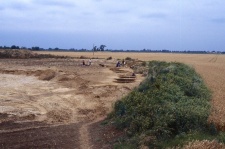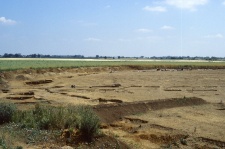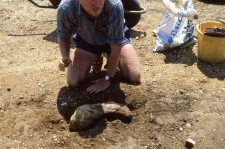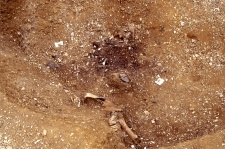A Neolithic causewayed enclosure was excavated between 1982 and 1987 in advance of gravel extraction. The site occupied a low knoll, around which were the meandering and extinct courses of a stream or river channel. This is one of at least six causewayed enclosures in the region, two of these are in Lincolnshire at Barholm and Uffington, making this the largest concentration in Britain outside Wessex and the Cotswolds.
The enclosure is less than 1km away from a smaller single causewayed circuit to the south and only 80m away from Etton Woodgate causewayed enclosure to the west. These three sites are the earliest elements in an extensive and long-lived monument complex in the Welland Valley.
The enclosure is defined by a single circuit of interrupted ditches enclosing an area 180m east-west by 140-160m north-south. Three principal entrances were noted to the north, east and west, but none could be located to the south because the southernmost part of the enclosure had been destroyed by a broad drainage channel, the Maxey Cut.
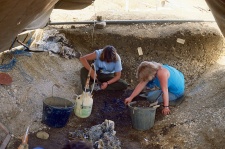
Excavation of brushwood, the covers were necessary to prevent drying out and to protect archaeologists in an exceptionally hot summer (1983)
The excavations recovered large quantities of waterlogged material from the ditches. Human remains, pottery, bone and lithic artefacts forming apparently “placed” deposits, typically occurred at the ends of ditch segments. Evidence for coppicing was also identified. Environmental evidence suggests that the site was prone to seasonal wetness and that cereal crops were both grown and processed within the immediate vicinity, perhaps within the enclosure. In its first phase of use, the interior was divided into two halves of quite distinct characters by a north-south ditch and line of post holes.
Recent research into the dating of the enclosure suggests that Neolithic activity at Etton started probably in 3725-3670 cal BC. The primary use of the enclosure ended probably in 3310-3210 cal BC. The initial use of the enclosure lasted probably for 380-510 years.
The excavations were part of a much wider landscape research project the results of which are invaluable for our understanding of the Neolithic in south Lincolnshire.
Beadsmoore, E., D. Garrow & M. Knight, 2010. Refitting Etton: Space, Time, and Material Culture Within a Causewayed Enclosure in Cambridgeshire. Proc Prehist Soc, 76, 115-34.
French, C.A.I., 2005. Archaeology and the Environment of the Etton Landscape, E Anglian Archaeol Rep 109.
Pryor, F., C. French & M. Taylor, 1985. An Interim Report on Excavations at Etton, Maxey, Cambridgeshire, 1982-1984. Antiq J, 65(2), 275-311.
Pryor, F.M.M., 1998. Etton. Excavations at a Neolithic causewayed enclosure near Maxey Cambridgeshire, 1982-7, London: Engl Heritage Archaeol Rep.
